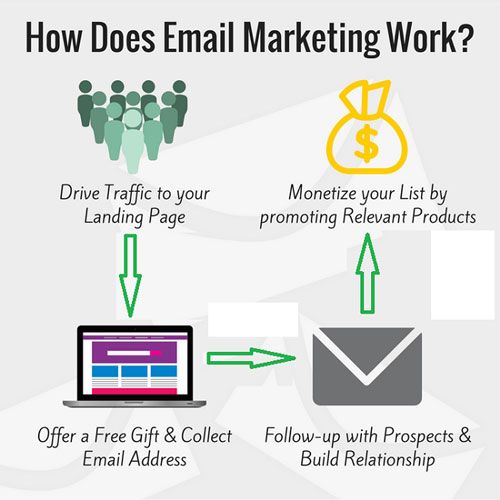Email marketing is a powerful tool. It connects businesses directly to customers’ inboxes.
Email marketing can drive sales, build relationships, and boost brand awareness. Imagine reaching your audience with just a click. Email can do that. It’s cost-effective and measurable. This blog post will guide you on how to use email for marketing.
From creating compelling content to tracking performance, you’ll learn the basics. Get ready to explore the steps that will help your business grow. Whether you’re a beginner or looking to refine your skills, this guide is for you. Let’s dive in and make email marketing work for you.
Table of Contents
Introduction To Email Marketing
Email marketing is a powerful tool for businesses. It allows direct communication with your audience. Using email, you can send messages, promotions, and updates. This method is cost-effective and efficient. Many businesses use email marketing to grow their customer base.
Importance Of Email Marketing
Email marketing is crucial for several reasons. It helps build relationships with customers. This form of marketing allows you to reach customers directly. Emails can be personalized, making them more effective. Here are some key points to understand its importance:
- Email has a wide reach.
- It is cost-effective.
- Emails can be personalized.
- It helps build customer loyalty.
Benefits For Businesses
Email marketing offers many benefits for businesses. These benefits help improve sales and customer engagement. Some of the main advantages include:
| Benefit | Description |
|---|---|
| Cost-Effective | Email marketing is cheaper than traditional advertising. |
| High ROI | Businesses see a high return on investment with email marketing. |
| Measurable | You can track the performance of your email campaigns. |
| Targeted | Emails can be sent to specific segments of your audience. |
By using email marketing, businesses can stay connected with their audience. It also helps in promoting new products and services. Thus, email marketing is a valuable strategy for any business.

Building An Email List
Building an email list is crucial for successful email marketing. The list is the foundation of your campaign. It connects you with your audience. A strong email list ensures your messages reach the right people. This section explores three key strategies to build an email list: Opt-In Forms, Lead Magnets, and Segmentation.
Opt-in Forms
Opt-in forms are essential for collecting email addresses. Place these forms on your website where visitors can easily find them. Use clear and inviting language to encourage sign-ups. Consider adding opt-in forms in these locations:
- Homepage
- Blog posts
- Landing pages
- Pop-ups
A well-designed opt-in form should have the following elements:
| Element | Description |
|---|---|
| Headline | Grab attention with a compelling headline. |
| Call to Action | Use a clear and strong call to action. |
| Minimal Fields | Ask only for essential information. |
| Privacy Assurance | Reassure users their email is safe. |
Lead Magnets
Lead magnets are incentives offered in exchange for email addresses. They provide value to potential subscribers. Effective lead magnets can significantly increase your email list. Examples of lead magnets include:
- eBooks
- Checklists
- Templates
- Webinars
To create an effective lead magnet, ensure it addresses a specific problem or need. Make it easy to access and valuable to your target audience.
Segmentation
Segmentation involves dividing your email list into smaller groups. These groups share common characteristics. Segmentation allows you to send more personalized and relevant emails. Common ways to segment your email list include:
- Demographics
- Geographic location
- Past purchases
- Website behavior
By segmenting your email list, you can tailor your messages. This increases engagement and improves your email marketing results.
Crafting Effective Emails
Emails are a powerful marketing tool. But, their success depends on how well they are crafted. Crafting effective emails is an art. You need to focus on three main elements: the subject line, the email body, and the call to action. Let’s dive into each one.
Subject Lines
The subject line is the first thing your recipient sees. It should be short and catchy. Aim for 50 characters or less. Use action words to create urgency. For example, “Don’t Miss Out on Our Sale!” or “Get Your Free Ebook Today!” Avoid using words that sound spammy, like “Free” or “Buy Now”. Personalization can also boost open rates. Try including the recipient’s name. Example: “John, Your Exclusive Offer Awaits!”
Email Body
The email body should be clear and concise. Start with a friendly greeting. Then, get straight to the point. Use short paragraphs and bullet points. This makes the email easy to read. Include relevant images to break up text. Make sure your content is valuable. This keeps your audience engaged. For example:
- Share tips and tricks
- Offer exclusive deals
- Provide updates on products or services
Always write in a conversational tone. This helps build a connection with your readers.
Call To Action
Your call to action (CTA) is crucial. It tells your reader what to do next. Be clear and direct. Use action words like “Shop Now,” “Learn More,” or “Sign Up.” Place your CTA in a prominent spot. A button is more effective than a text link. Ensure the button stands out with a contrasting color. For example:
| Action | CTA Example |
|---|---|
| Shop | |
| Learn | |
| Sign Up |
Make sure the landing page for your CTA matches the email content. This provides a seamless experience for your readers.
Design And Layout Tips
Designing an effective email for marketing involves more than just words. The layout and design play a crucial role in grabbing the reader’s attention. A well-designed email can improve engagement and conversion rates. Here are some key design and layout tips to ensure your email marketing efforts are successful.
Mobile-friendly Design
Most people check their emails on mobile devices. It’s essential to make sure your email is mobile-friendly. Use a single column layout. This ensures the content displays correctly on smaller screens.
Keep your font size at least 14px for easy reading. Buttons should be large enough to tap easily. Use responsive design techniques. This helps the email adapt to different screen sizes. Test your emails on various devices and email clients to ensure they look good everywhere.
Visual Elements
Visual elements can make your emails more engaging. Use high-quality images to grab attention. Avoid using too many images as it can slow down loading times.
Utilize alt text for images. This ensures your message is conveyed even if the images don’t load. Use a consistent color scheme that aligns with your brand. This helps in creating a professional look.
Include white space to make your email easy to read. Don’t overcrowd your email with too much information. Break up text with bullet points or short paragraphs.
Personalization
Personalization can significantly improve engagement. Use the recipient’s name in the subject line or greeting. This makes the email feel more personal.
Segment your audience based on their preferences or behavior. This allows you to send targeted messages. Use dynamic content to tailor the email to each recipient. For example, show different products based on past purchases.
Include personalized recommendations or offers. This increases the chances of conversion. Make sure your email feels like it was made for the recipient, not a mass audience.
Here is a quick summary in a table format:
| Tip | Details |
|---|---|
| Mobile-Friendly Design | Single column layout, large fonts, responsive design, test on devices |
| Visual Elements | High-quality images, alt text, consistent color scheme, use white space |
| Personalization | Use names, segment audience, dynamic content, personalized offers |
Automation And Workflows
Email marketing is more effective with automation and workflows. Automating emails saves time and ensures timely communication with your audience. Workflows guide your subscribers through a journey, enhancing their experience.
Welcome Series
A Welcome Series is the first interaction your subscribers have with your brand. It sets the tone for future communications. An effective welcome series:
- Introduces your brand and values
- Provides valuable information
- Encourages engagement
Create a sequence of emails that:
- Thank the subscriber for joining
- Introduce your products or services
- Offer a special discount or incentive
Drip Campaigns
Drip Campaigns are a series of automated emails sent at specific intervals. They nurture leads over time. Key benefits of drip campaigns include:
- Keeping your brand top-of-mind
- Building trust with your audience
- Guiding subscribers towards a purchase
To create an effective drip campaign:
- Identify your goals
- Segment your audience
- Write engaging and relevant content
Behavioral Triggers
Behavioral Triggers send emails based on specific actions taken by your subscribers. These actions can include:
- Visiting a specific page on your website
- Abandoning a cart
- Making a purchase
Behavioral triggers help you:
| Action | Email Example |
|---|---|
| Cart Abandonment | Send a reminder with a discount |
| Purchase | Send a thank you email |
| Website Visit | Send a follow-up email with related content |
Using behavioral triggers improves the relevance of your emails. This increases engagement and conversions.

A/b Testing
A/B Testing is a powerful tool in email marketing. It helps you understand what works best. By comparing two versions of an email, you can see which one performs better. This method can improve your open rates and conversions.
Subject Line Testing
The subject line is the first thing people see. A good subject line can make a big difference. To test subject lines, create two versions. Send each version to a small group from your list. See which one gets more opens. Use these tips for better results:
- Keep it short and clear
- Use action words
- Include numbers or lists
- Ask a question
Content Testing
Content is the heart of your email. Testing different content can show what your audience likes. Create two versions of your email. Change one element at a time. For example, test the headline first, then the images. Use these elements for testing:
- Headlines
- Images
- Call-to-action buttons
- Body text
Analyzing Results
After sending the emails, check the results. Look at the open rates, click rates, and conversions. Use a table to compare the performance:
| Version | Open Rate | Click Rate | Conversions |
|---|---|---|---|
| A | 25% | 5% | 10 |
| B | 30% | 7% | 15 |
Pick the version that performs better. Use the insights to improve future emails. Repeat the process to keep improving.
Metrics And Analytics
Understanding metrics and analytics is crucial for email marketing success. It helps you measure performance and make data-driven decisions. In this section, we will discuss key metrics: open rates, click-through rates, and conversion tracking.
Open Rates
The open rate indicates how many recipients opened your email. It is a critical metric for gauging interest. A high open rate suggests your subject line is effective. To improve open rates, consider:
- Crafting compelling subject lines
- Using personalized greetings
- Sending emails at optimal times
Track your open rates consistently. Make adjustments based on the data.
Click-through Rates
The click-through rate (CTR) measures how many people clicked on links within your email. This metric shows the effectiveness of your content. To increase CTR, try:
- Including clear call-to-action (CTA) buttons
- Using engaging visuals
- Writing concise and relevant content
Monitor your CTR regularly. Optimize your email content for better engagement.
Conversion Tracking
Conversion tracking helps you understand the end goal of your email campaigns. It measures how many recipients completed a desired action, such as making a purchase. To track conversions, ensure you:
- Define clear goals for each campaign
- Use tracking codes and tags
- Analyze the data to improve future campaigns
Effective conversion tracking can help you refine your strategy. Focus on achieving higher ROI.
| Metric | Purpose | Tips for Improvement |
|---|---|---|
| Open Rates | Measure email opens | Use compelling subject lines |
| Click-Through Rates | Measure link clicks | Include clear CTAs |
| Conversion Tracking | Measure goal completions | Define clear goals |
By focusing on these metrics, you can enhance your email marketing campaigns. Always analyze and adjust based on your data.
Compliance And Best Practices
Email marketing can be a powerful tool for reaching your audience.
But it is important to follow rules and best practices.
This ensures your emails are effective and legal.
Here, we will cover key regulations and guidelines.
Can-spam Act
The CAN-SPAM Act sets rules for commercial emails in the United States.
It gives recipients the right to stop receiving emails.
Key points include:
- Do not use false or misleading headers.
- Avoid deceptive subject lines.
- Identify the message as an ad.
- Include your valid physical address.
- Provide a clear way to opt out of emails.
- Honor opt-out requests promptly.
Gdpr
The General Data Protection Regulation (GDPR) affects email marketing in the European Union.
It focuses on data privacy and protection.
Important points include:
- Get clear consent before sending emails.
- Allow easy withdrawal of consent.
- Provide access to personal data upon request.
- Ensure data is kept secure and confidential.
- Report data breaches within 72 hours.
Email Frequency
Sending too many emails can annoy subscribers.
Sending too few can make them forget you.
Finding the right balance is key.
Consider these best practices:
- Start with a moderate frequency. Weekly or bi-weekly works well.
- Monitor engagement. Adjust based on open rates and feedback.
- Segment your list. Send targeted emails to specific groups.
- Respect preferences. Allow subscribers to choose how often they hear from you.
Following these guidelines will help you stay compliant and keep your audience engaged.
Use these best practices to improve your email marketing strategy.
Case Studies
Email marketing is a powerful tool for businesses to connect with their audience. By exploring case studies, you can learn from successful campaigns and understand the lessons learned. This way, you can create effective email marketing strategies for your business.
Successful Campaigns
Many companies have run successful email marketing campaigns that resulted in increased engagement and sales. Here are a few examples:
| Company | Campaign | Results |
|---|---|---|
| Company A | Holiday Promotion | 25% increase in sales |
| Company B | New Product Launch | 30% higher engagement |
| Company C | Customer Feedback | Improved customer satisfaction |
Lessons Learned
From these case studies, several valuable lessons can be drawn:
- Personalization: Tailor your emails to individual customers for better results.
- Timing: Send emails at the right time to increase open rates.
- Clear Call to Action: Make it easy for recipients to understand what to do next.
By studying these successful campaigns and lessons, you can improve your email marketing efforts. Remember to always test different strategies and measure your results to keep refining your approach.

Future Trends
The future of email marketing is evolving rapidly. With technological advancements, businesses need to stay ahead. Let’s explore some future trends in email marketing.
Ai And Automation
AI and automation are transforming email marketing. They help in personalizing emails and improving engagement. AI can analyze customer data to predict preferences. This ensures the right message reaches the right audience.
Automation saves time and effort. It allows for scheduling and sending emails based on user behavior. Here are some benefits:
- Increased efficiency
- Better targeting
- Enhanced customer experience
Incorporating AI and automation can lead to higher open rates and conversions. Marketers can focus on strategy while the tools handle repetitive tasks.
Interactive Emails
Interactive emails engage users more effectively. They include elements like surveys, quizzes, and videos. Users can interact without leaving their inbox.
Some popular interactive elements are:
- Carousels
- Accordion menus
- Embedded forms
Interactive emails improve user experience and drive higher engagement rates. They keep the audience engaged and make the email content more dynamic.
By adopting these future trends, businesses can enhance their email marketing strategies. Embracing AI and interactive elements can set them apart in a competitive market.
Frequently Asked Questions
What Is Email Marketing?
Email marketing is a digital strategy to promote products or services. It involves sending emails to potential customers. It’s effective for building relationships and driving sales.
How Does Email Marketing Work?
Email marketing works by sending targeted emails to a subscriber list. These emails can include promotions, newsletters, or updates. The goal is to engage the audience and encourage actions.
Why Is Email Marketing Important?
Email marketing is important because it reaches a large audience directly. It’s cost-effective and measurable. It helps in building customer relationships and driving conversions.
How To Create An Email Marketing Campaign?
To create an email marketing campaign, start by defining your goals. Then, build your email list and design engaging content. Finally, send and monitor the results.
Conclusion
Successful email marketing requires careful planning and consistent effort. Focus on building a strong subscriber list. Create engaging, relevant content for your audience. Personalize emails to make recipients feel valued. Track results to refine your strategy. Stay compliant with regulations to maintain trust.
Test different approaches to discover what works best. Effective email marketing can boost your business growth. Keep learning and adapting for continued success.



Leave a Reply